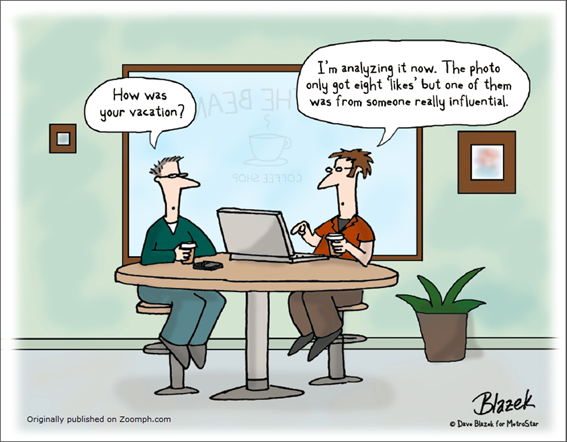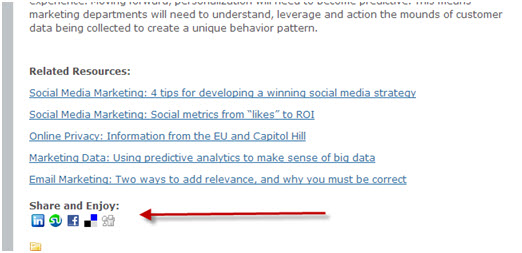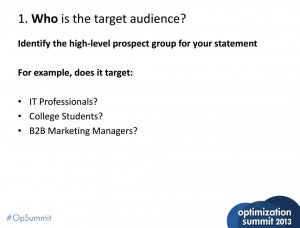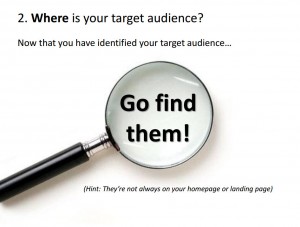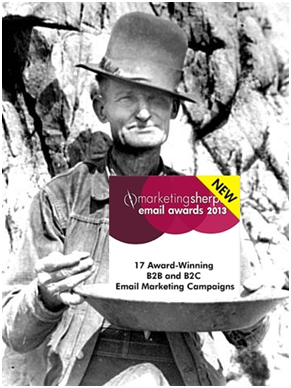Top MarketingSherpa Blog Posts of 2013: 10 lessons in social media, content and email marketing
After tallying up the number of times our audience shared posts, social media, content and email marketing are the areas to receive the most tweets from your peers. That means inbound marketing as a whole once again reigned supreme on the MarketingSherpa Blog, earning 10 of the top 15 spots of 2013. We’ll break down these three areas with key lessons we can learn and apply to our efforts in the new year.
And, since this list is all about the tweets, we’ll include some interesting ones about select posts. Carry on to learn the top 10 lessons of 2013.
Social Media Lessons
Lesson #1. Adapt your social content so that it is appropriate for each social media platform
In his post, “Social Media Marketing: Which type of content is appropriate for different platforms?” Jonathan Greene, Business Intelligence Manager, MECLABS, used an unusual set of analogies to help marketers understand what tone and content to use on Facebook, Twitter and LinkedIn.
Read this post to learn about the personality each platform has, and how you can effectively put them to work.
Great lighthearted analysis of social media for businesses RT @MarketingSherpa Social Media Marketing: http://t.co/N94IbPF7cZ
— Mike Garrison (@mikejgarrison) May 21, 2013
Lesson #2. Be able to answer why customers should like or follow you
When it comes to social media buttons, you should ask yourself why your customers should follow you. This can be a tougher question for companies that aren’t natural content producers.
You must provide some value for customers in exchange for the privilege to show up in their newsfeed. Value can be ongoing, like exclusive discounts just for Twitter followers, or a one-time opportunity, such as a chance to win a prize.
Read more about this question, and three others, in the post, “Social Media Marketing: 4 questions to ask yourself about social media buttons.” You can also use value proposition to better answer this question, as described by Jonathan Greene in this post, “Social Media Marketing: Why should I like or follow you?”
Lesson #3. Add visual elements to your social media content
While a quote is just words, it doesn’t mean you can’t bring a visual component to the content. The New York Public Library created graphics for an already popular content type – celebrity quotes – to create a social media campaign with impressive results. Learn more about its efforts from Courtney Eckerle, Manager of Editorial Content, MECLABS: “Social Media Marketing: How New York Public Library increased card sign-ups by 35%.”
Interestingly, it seems this post was the most shared on Twitter for certain individuals:
@librarydonna Hi Donna. Hope you’re well. Saw this social media campaign from New York Public Library. Thought of you http://t.co/uIywx1alES
— John Madden (@ja_madden) March 11, 2013
Lesson #4. Go beyond the “like” to track your social media success
David Kirkpatrick, Manager of Editorial Content, MECLABS, broke down a chart covering social media marketing metrics tracking in the post, “Social Media Marketing: Social metrics from “likes” to ROI.” While social reach (e.g., “likes”) tops the list, some marketers are also measuring ROI, leads and conversion. See what other metrics your peers are using to benchmark success in their organizations.
Content Marketing Lessons
Lesson #5. Analyze your blog to identify areas for improvement
There are a lot of elements that make up your blog. When was the last time you stood back to evaluate if all of those pieces were working as well as they could?
In his post, “Content Marketing: An 8-point analysis for your blog,” Daniel Burstein, Director of Editorial Content, MECLABS, explained the eight points on which to focus your evaluation. From the frequency of your posts and their titles, to author bios and social media integration, you could have untapped potential waiting to be found.
Great #blog pointers from @MarketingSherpa: Be consistent, provide value, tell the world about it http://t.co/VbVj4hQhoV
— Francis Moran (@FrancisMoran) February 26, 2013
Lesson #6. Use WordPress, or any tool, to its fullest potential
No matter what channel or platform you’re using, you want to get all you can out of it. For the post, “Content Marketing: 5 tips for WordPress blogging,” Erin Hogg, Copy Editor, MECLABS, broke down some ways she’s learned to improve a WordPress blog. Learn how to cross promote media with embedding, use basic HTML to improve the look and feel of a post, and more.
Lesson #7. Implement (and stick with) a style for your content
AP? Chicago? MLA? APA? There are many established styles, and one might work as-is for your organization. You could decide to create your own. At MECLABS, we use the Associated Press Style Book as our foundation and supplement it with a set of our own guidelines.
No matter which direction you choose, it’s important to stick with the guide for all of your content. Having well-proofed and consistent content adds to the credibility of your content and builds the authority of your brand.
Erin Hogg explained this and other tips in her post, “Content Marketing: 7 copy editing tips to improve any content piece.”
Yes, please #copyedit! RT @MarketingSherpa Content Marketing: 7 copy editing tips to improve any content piece http://t.co/NeMBCh85rU
— Christine Parizo (@cparizo) October 30, 2013
Email Marketing Lessons
Lesson #8. Don’t forget about current customers when designing triggered email campaigns
In the post, “Email Marketing: 3 overlooked aspects of automated messages,” Daniel Burstein said nurturing current customers is one of the most overlooked automated email opportunities. He shared a list of triggered email types you can implement to strengthen relationships with you customers, including product education and upselling.
This post also features two other overlooked aspects of automated emails: customer lifetime value and the gap between what marketers should do and what they actually do.
Some great insights into better managing your automated emails… http://t.co/H2H5zWZ0Dd
— Dustin Luther (@tyr) April 1, 2013
Lesson #9. Test your emails to discover what really works for your audience
You could be using every best practice you’ve come across, but unless you know it’s best for your specific audience, then it might not be the practice you should be using. Testing lets you know what your audience best engages with.
Justin Bridegan, former Senior Marketing Manager, MECLABS, explained how testing revealed two segments of the MarketingSherpa email list prefer different email lengths. Read on to learn his other tips in the post, “Email Marketing: What I’ve learned from writing almost 1,000 emails for MarketingSherpa.”
“Write your copy with the understanding that your audience is likely not reading, but skimming” http://t.co/UkkkEa6uTR
— Elizabeth Sosnow (@elizabethsosnow) August 26, 2013



